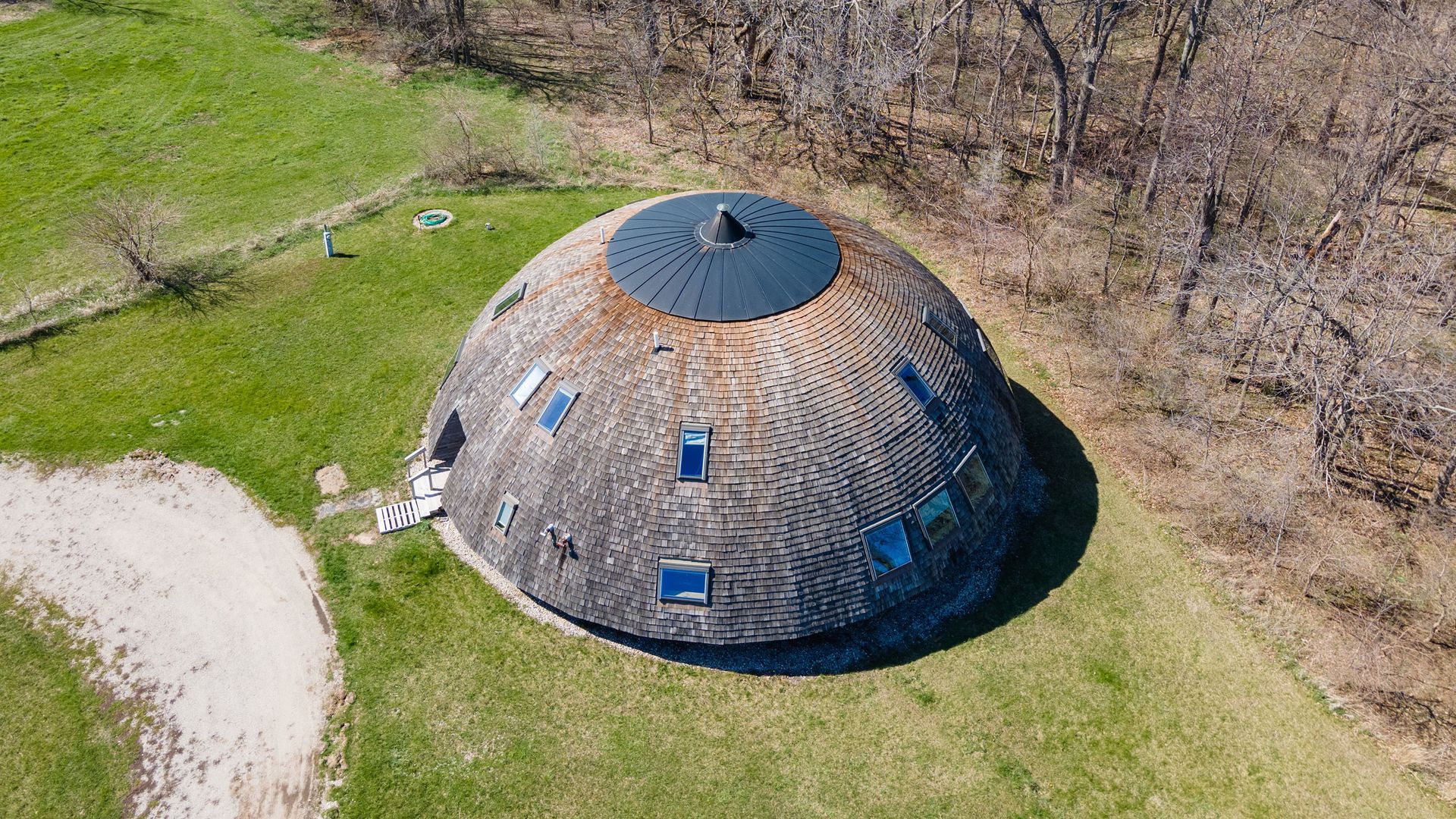
Posted on 08/06/2023 12:40:54 PM PDT by Right Wing Vegan

More people are talking about dome homes and disaster-proof designs as a solution to climate threats.
Why it matters: Experts say increasing extreme weather could give mass-market appeal to dome structures, which are relatively cheap to build and resilient against hurricane-force winds, Axios' Cuneyt Dil writes.
What they're saying: Natural Spaces Domes, a Minnesota-based company with customers across the country, has seen demand surge in recent years. Owner Dennis Odin Johnson tells Axios he's doubled his staff and expects to sell around 40 domes this year, up from 20 last year.
"Our clients are looking for something different, and they're attuned to climate change," Johnson says.
Zoom in: The shape certainly stands out in Somonauk, about an hour from Chicago, where owner Bill McVay said he recently listed his 4,000-square-foot dome for $475,000.
"The wind just goes around it," McVay tells Axios, referring to the property he and his partner, a late radio psychic, had built in 2002.
They wanted to "stay off the grid as much as possible," and found the home's energy efficiency and then-secluded location especially appealing.
The big picture: With fewer flat walls and its round shape, domes can weather severe winds and heavier snowfall while using less heating and cooling energy than a conventional house, Johnson says.
Also, the entire exterior can be built with fire-resistant material.
The intrigue: The geodesic dome structure was popularized by famed 20th-century inventor R. Buckminster Fuller, who lived in a Carbondale dome while working as a professor at Southern Illinois University.
By the numbers: A completed dome is generally 5-to-15% less expensive to build, requiring 60% less lumber than a standard house of the same size, according to Johnson.
For an average-size dome, completed building costs range from $350,000 to $450,000 in rural areas, with costs up to 50% higher in cities and suburbs, he says.
Details: Other perks include low-maintenance living. "There are no gutters to clog or surfaces to repaint," reads an advertisement for the home McVay got from Domespace, a Canadian company that once viewed its fleet of spinning domes as "the homes of the future."
"It is virtually impossible for the roof to leak, as it has no valleys and ridges," the flyer reads.
Roughly 2% of people in Illinois say they were displaced in the last year because of a natural disaster, per the latest U.S. Census Bureau data.
Nationwide, the average is 1.6%.
Louisiana, Oklahoma and Florida saw the highest share of disaster-related displacement among U.S. states, the data shows.
What's happening: The threat of climate change-related disasters is a big factor driving up consumer costs and putting insurers out of business in parts of California, Florida, Louisiana and elsewhere, Axios' Andrew Freedman and Nathan Bomey report.
Where do they find these people?
“McVey and his partner, a late radio psychic”
Need we say more?
Good concept but storm force winds will rip those ugly shingles right off. Plus the climate change reason is bunk.
“Experts say” = non-starter right off the bat ...
nonetheless, domed residential structures are a frigging nightmare inside and out ... good luck with preventing leaking around ANY exterior opening, whether a pipe, door or window ...
oh, and good luck installing interior walls ...
Went to the website. Looked at some of the products. Blecch. I wager the company is a “product placement” and not news.
Houses that look like b@@bs are selling like hotcakes.
Was wondering about that myself. How do these dome homes do during floods and blizzards might be more pertinent.
Domes were the rage with leftists back in the 70’s. Maybe leisure suits are coming back next.
Racist!
/s
With a pink aircraft warning light at the tippy top!
FTP warning light.
IMO, dome shaped houses are a disaster.
Unattractive and not as resistant to adverse weather as they claim. The winds can still lift the roofing shingles off the roof from the direction the winds are coming from.
And they don’t look very space efficient. Closets in shapes of wedges with curved walls? Bedrooms with curved walls? How to beds and dressers fit in there without wasting space?
What about kitchen cupboards and countertops?
“Our clients are looking for something different, and they’re attuned to climate change,” Johnson says.”
So he has idiot suckers for clients. Fleece them.
For $150,000 you can buy a manufactured home of the same size.
I was 3 miles from the epicenter of the Loma Prieta quake.
A dresser fell over but the house (39 ft dome circa ‘78)
was fine.

Shingles won’t lay very flat on the surface of a dome like the one pictured. The “roof” pitch is not the same on all parts either, so you’d need to be careful with the nailing too. The windows and doors will be more likely to leak as well.
All I see from that is more problems than solutions.
Domes could be practical for earthquake prone areas.
Dome home on Sullivan Island near Charleston with pictures.
https://www.realtor.com/news/unique-homes/dome-house-hurricanes-south-carolina/
It would be better to get one that can take a few shells.
Disclaimer: Opinions posted on Free Republic are those of the individual posters and do not necessarily represent the opinion of Free Republic or its management. All materials posted herein are protected by copyright law and the exemption for fair use of copyrighted works.